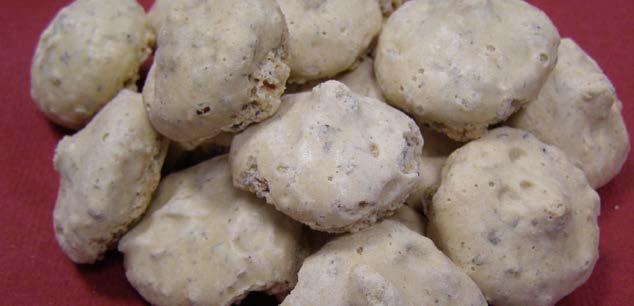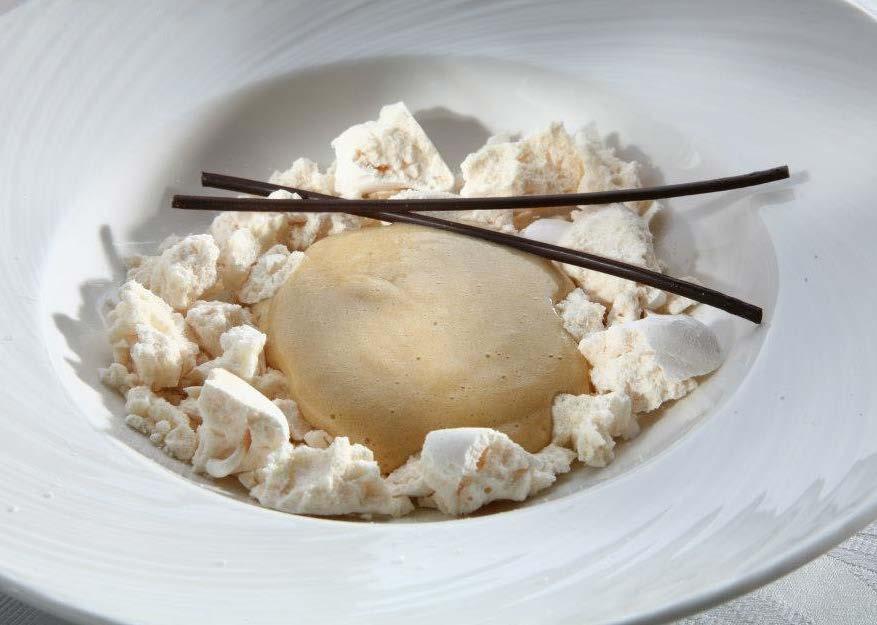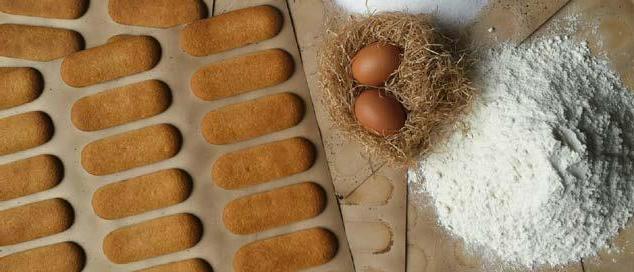
8 minute read
Desserts
Biscotti di Riso (rice biscuits)
Recipe serves 4 people
Advertisement
Ingredients
• 200 g rice flour • 1 egg • 60 g sugar • 75 g butter • grated lemon zest • 1 pinch of salt
Instructions
Beat the eggs with sugar in a large bowl; when the sugar has melted, add the softened butter a little at a time, mixing until it is well blended. Add the lemon zest, a pinch of salt and the rice flower slowly from above. Work the mixture until it becomes quite stiff, like when making shortcrust. Make a ball and wrap it in cling film, resting the dough for 30 minutes in the fridge. Roll out the dough with a rolling pin between two pieces of parchment paper until it’s 5-6 cm thick. Cut out the biscuits and bake on a parchment lined tray at 180°C ventilated for about 15 minutes.

Brutti ma Buoni alla Novarese
Recipe serves 6 people
Ingredients
• 500 g granulated sugar • 350 g fresh egg whites • 650 g toasted and chopped almonds • 200 g powdered sugar • Vanilla to taste
Instructions
Beat the egg whites, the sugar and vanilla to stiff peaks. Add the toasted almonds with the powdered sugar, mixing very delicately. Roll into small-medium balls (about 2/2.5 cm diameter) and lay out on the parchment paper. Preheat the oven to 160°C for 40 minutes leaving the oven door open by 3 mm. Cook until they easily peel off the paper. Remove from the oven and let cool completely. Keep the product away from humidity and light (in closed boxes, pelure/tissue paper). Keeps for: 8-10 days.
A little history
This sweet was first made in 1869 in Borgomanero where an “Offellerie”, a pastry shop, was opened. The “Brutti ma Buoni”, which at a glance look like little care was made in their production, due to them being all different sizes and shapes, are delicious to munch on and have a delicate and aromatic flavour. The recipe was kept secret by the Professional Pastry chefs of Borgomanero who would pass the recipe down, and even today, with careful mastery confer the true original flavour to the product. There are many imitations, but the ones produced in Borgomanero are the only original ones.
Recipe serves 8 people
Ingredients
• 300 g 00 flour • water and sourdough starter or leavened bread dough • walnuts, chopped hazelnuts and almonds to taste • sultanas and dried figs to taste • 3 eggs • 1 tablespoon honey • cinnamon to taste • a pinch of bicarbonate ammonium • 100 g sugar • breadcrumbs as needed
Instructions

Mix the flour with the yeast and the water like you do for bread. Add to the mix, or to the leavened bread dough, the sugar, honey, soaked sultanas, walnuts, almonds and chopped dried figs. Mix everything together. Grease a baking tin, cover it with breadcrumbs, make some balls, flatten them slightly with your hands and place in the tin, then cover with sugar. Bake for 40 minutes at 180° C.
A little history
The Büsaróla is a typical sweet from Romagnano Sesia, an ancient custom of the local farming culture. Originally, the Büsaróla was a simple dessert, rustic and original, always different due to the fact that it was improvised. To flour and butter, with a little egg and a little sugar (sometimes even simple bread dough would suffice), you would add the available fruit: smoke-dried Uva Americana, dried figs, walnuts and hazelnuts gathered from the woods, honey. It was the cake that characterised festivities: it was most commonly prepared for the harvest, in the vineyards on the morainic hills of the Monteregio, where excellent DOCG and DOC wines are produced. The sweet has been rediscovered by local pastry shops and it is well loved and appreciated for its authenticity, the aroma and the scent of tradition that it encloses.

San Gaudenzio’s Bread
Recipe serves 6 people
Ingredients
For the shortcrust • 250 g 00 Flour • 150 g softened butter • 100 g granulated sugar • 1 egg • 1/2 pod of vanilla, seeds • grated lemon zest • 1 pinch of salt • 1 teaspoon of baking powder For the filling • 130 g 00 Flour • 130 g granulated sugar • 100 gcandied chestnuts • 75 g melted butter • 4 eggs • 1 teaspoon of lemon juice • 1/2 pod of vanilla, seeds • 1 handful of hazelnuts, almonds, pine nuts
Instructions
To prepare the pastry, create a well with the flour and add the sugar and a pinch of salt. In the centre of the well, shred the butter, add the egg, the baking powder, the lemon zest and the vanilla pod seeds. Mix everything quickly, working the dough with your hands. When the dough is smooth and uniform, make a ball and place it in the fridge to rest for an hour. Prepare the filling: beat the egg whites to stiff peaks, adding a teaspoon of lemon juice and in a different bowl, beat the yolks with the sugar. Add the egg yolks to the whites, folding gently. Add the flour, the candied chestnuts that have already been chopped, the melted butter and the vanilla pod seeds. Take the pastry from the fridge and roll it out to a thickness of 4 mm. Butter and flour a loaf pan and place the pastry in it. Add the filling, cover the chopped hazelnuts, the almonds and pine nuts. Sprinkle with powdered sugar and cook in a 190°C oven for about 45 minutes.
Stuffed Peaches
Recipe serves 6 people
Ingredients
• 6 yellow peaches • 70 g Amaretti biscuits • 1 tablespoon of unsweetened cocoa • 40 g raw cane sugar • 20 g almonds • 1 glass of fortified sweet wine • butter as needed

Instructions
Wash and dry the peaches, cut them in half and remove the stones. In a mixer blend together the butter, the crumbled biscuits, the almonds until you reach a smooth paste. Add the cocoa and the sugar. Place the mixture at the centre of each peach half. Place the peaches in a greased pan, pour the sweet wine over theme and cook in a preheated oven 200° C for about half an hour, basting them with the fond every so often. Serve the peaches straight from the oven with the sauce, decorating with a whole amaretto biscuit and some almonds. Serve with the Passito from the Colline Novaresi.
A little history
A tasty dish for the summer once made with the vineyard peaches.

Marsala Zabaione with Fiordilatte ice cream and meringues
Recipe serves 4 people
Ingredients
• 6 eggs • Marsala • 6 tablespoons of sugar • Meringues • Fiordilatte ice cream
Instructions
Beat 6 egg yolks with 6 tablespoons of sugar and six half eggshells-full of Marsala. Keep chilled. With a rolling pin, roughly flatten the meringues. Prepare some balls of fiordilatte ice cream and roll them in the crushed meringue. In a copper saucepan, the polsonetto, place the zabaione, which will be beaten over a direct heat. In a big cup, or in a nice looking soup plate, place a ball of ice cream and meringue and bring to the table. Serve the hot zabaione straight from the saucepan.

Biscottini from Novara
Ingredients
• 250 g sugar • 250 g flour • 4 eggs and 1 egg yolk • cane sugar to taste
Instructions
Work the sugar with the eggs and the yolk in a water bath: when it starts to thicken, remove from the heat and continue whisking it, mixing the flour in at the same time. With a piping bag, make some long strips on the parchment, spaced apart and 6-8 centimetres long, then sprinkle with cane sugar and bake. Let rest for 20 minutes, then place in the preheated oven at 180° C until they are golden brown. Remove them with a knife or a spatula immediately while still hot and let them dry by leaving them laying down on the table. They pair well with tea, chocolate, warm zabaglione or sweet wine.
A little history
Due to a lack of documentation, it is hard to establish the origins of the “Biscottini di Novara”: the first account dates back to the XVI century, when in the monasteries the nuns, among the few who could afford the precious ingredients, used to prepare the biscuits to give to the Pope and the other prelates in Rome. When Napoleon dissolved the convents, the tradition of the Biscottino fell into disuse, but the nuns, who had for centuries preserved the recipe and had found refuge in the homes of nobles and patricians, continued to produce this fragrant and affordable sweet. From that moment on, the secret for the creation of the biscuit was revealed and the product was very soon commercialized. A pharmacist-grocer from Novara, Mr. Prina, started producing them and sold them to the public as a tonic for the ill and convalescent. In the course of the 19th century, many pastry chefs and bakers started making them in the shape we know today, and the city of Novara became the “city of the Biscottini”.
Later on the Biscottini di Novara started being produced even on an industrial level, but even today they are still prepared in by hand in Novara.





